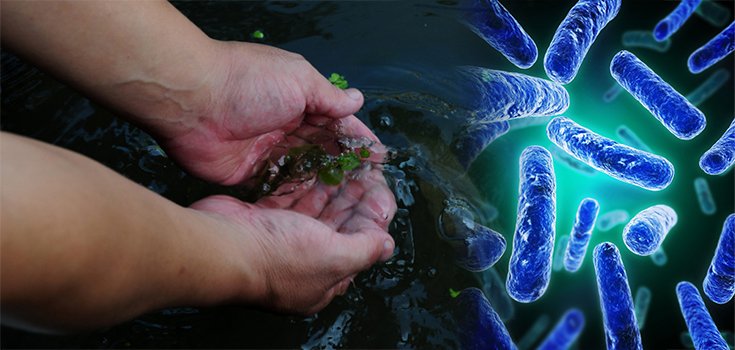Flesh-Eating Bacteria: What You Need to Know About Vibrio Vulnificus

So far this summer, 4 people along the Gulf Coast have been infected with a flesh-eating bacteria called vibrio vulnificus. The bacteria are often found in warm, shallow water. The infected individuals all became infected after spending time at the beach.
It’s not uncommon for people who have been infected to have a limb amputated. If it’s not caught early enough, or not treated aggressively enough, it can be deadly.
The FDA sees about 96 deaths by vibrio vulnificus each year – the bacteria is fatal 50% of the time. So far, in 2016, there have been 27 reported cases of infection.
It’s extremely rare that people become infected with flesh-eating bacteria; that’s why it always makes headlines. But since it’s in the news and it’s apparently a problem right now, you should know the facts about vibrio vulnificus, especially if you live near the Gulf Coast and plan on visiting a beach or participating in certain activities anytime soon.
Vibrio Vulnificus Fast Facts:
- The bacteria initially infiltrates the flesh between a person’s muscles and skin. Then, vibrio vulnificus releases a toxin that causes the immune system to release white blood cells that destroy the individual’s flesh. To tackle the spreading infection, either the affected tissue has to be amputated, or antibiotics have to be administered through an IV.
- One vibrio vulnificus enters the body, it incubates for about 2 to 5 days before it spreads throughout the body, eventually causing sweats, fever, and chills. The infection is usually diagnosed when a doctor spots red, swollen, blister-like patches on the patient’s body.
- Women contract vibrio vulnificus less often than men do, thanks to the estrogen in their bodies.
- 90% of all vibrio vulnificus infections come from eating raw Gulf Coast oysters.
- People most at risk for developing an infection from vibrio vulnificus are those with weakened immune systems, people who are HIV positive, people with diabetes, and the elderly. [1]

Dr. A. Scott Lea, a professor of internal medicine and infectious diseases at the University of Texas Medical Branch in Galveston, explained to Austin American-Statesman that people are far more likely to contract vibrio vulnificus from recreational injuries than from swimming in the ocean.
“Vibrio infection is much more likely to be associated with recreational injuries while fishing, boating or netting. People working around boats and docks have problems with Vibrio.
Most folks generally do not swim in bays, marshes or around boat docks. Things like fishhook injuries; fish, shellfish spine punctures; barnacle cuts; and wade fishing cuts (and) abrasions are much more likely to cause problems than a swimming exposure in the Gulf of Mexico.”
To prevent vibrio infection, Lea recommends showering immediately after getting out of the water, adding that “Antibacterial soaps contain antibacterial chemicals and may be of help.”
He also said that people should pay close attention to any skin that looks like it might be infected and seek medical attention right away. He explained:
“The fact that a person has been in the marine environment makes the possibility of infection due to vibrio and other problem microorganisms more likely. This is particularly important if the individual doesn’t live on the coast where physicians are not always ‘on the lookout’ for these infections.
Unnecessary delays in the proper diagnosis can lead to the prescription of inadequate antibiotics for this particular type of infection.
So, the concern about infection acquired on the beach or while fishing along the coast is a pivotal piece of information that should be brought to a physician’s attention.
Additionally, Leah says people should never eat raw shellfish. What’s more, he admits that steaming or quickly boiling them “may not be adequate for destruction of microorganisms.”
People who fish should also take certain precautions. He said:
“Puncture wounds and cuts incurred in the water while fishing are events that can result in inoculation of Vibrio into human tissues. Water shoes and waders provide some protection, but the most important activity is washing the wound with soap and water and being attentive to the occurrence of irritation at the wound site.
Fishermen are the group of people at highest risk in our experience at UTMB. They should bring these wounds to medical attention immediately, emphasizing the exposure to salt water.”
The Odds are Low
All of this sounds scary, but the odds of contracting vibrio vulnificus are only 1 in 50,000, or 0.00002% [1]
Lea said, encouragingly:
“I would not be afraid to go to the beach and enjoy the water and sun for a day.”
On a side note, Gulf Coast residents interviewed by The Guardian said they believe a man-made disaster is to blame for vibrio vulnificus in the area.
Kim Farve, director of public works in Bay St Louis, Mississippi, said:
“I’ve got my theory. They say this vibrio has been in the water forever. But I grew up on the water, and I don’t remember it ever being a problem until after the [2010] BP oil spill.”
Biloxi, Mississippi, resident Jocko Angle, who himself battled a vibrio infection, has the same theory.
“I think the oil in the water, combined with the chemicals they used, created the perfect environment for vibrio to thrive.”

Sources:
[1] Mic

Vibrio is found to infect those with excess iron at a very high rate and since women are commonly low in iron as opposed to men, the real reason women catch it less than men may be due to their low levels of iron as opposed to their ‘protection’, estrogen. Imho.
“These results show that V. vulnificus is a ferrophilic bacterium that requires higher NTBI levels than other pathogens and that iron chelation therapy might be an effective means of preventing the in vivo growth of V. vulnificus in susceptible patients.”